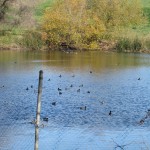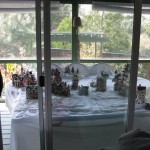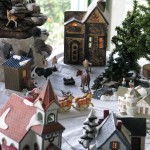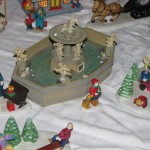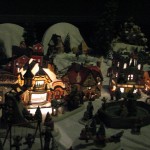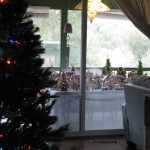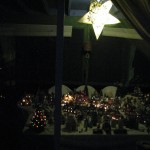-
Salton Sea

Salton Sea is a terminal sea; there is no connection to any other water Salton Sea is a terminal sea, created by accident in 1905 by a break in an irrigation canal from the Colorado River.

Trains a hundred cars long pass by regularly Salty and as it evaporates, becoming saltier, the sea hosts water sports, camping, and in the summer black flies by the millions, temperatures well over 100F, and the smell of rotting fish. However it is also one of the birding hotspots of the United States, as it is located along the Pacific Flyway in the Imperial Valley.

Black-necked stilt My daughter and I took advantage of the cooler post-Christmas weather and drove there last week. Winter is the best time to see birds and we weren’t disappointed.

Great egrets rest in the trees by the Visitor's Center The drive was a little over two and a half hours from our home, skirting the mountains and into the desert communities.The Sea is about 35 miles long, and is about 227 feet below sea level. The north-west part of Salton Sea hosts the visitor’s center and some good birding areas, but the best areas for us were about thirty miles south (it isn’t called a sea for nothing!) at the Sonny Bono Salton Sea National Wildlife Refuge, Unit #1.

Pelagic birds dining at Sonny Bono Fish die-off is a sad part of the life cycle of the mineral-heavy sea, and the sand is layered with the decomposing bones of millions of fish.
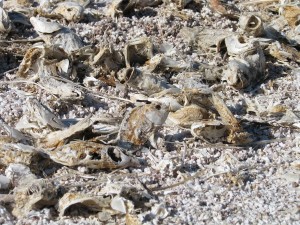
The sand is made of disintigrating fish bones Thousands of birds in enormous flocks can be seen all around the Sea. It is a grand thing to witness; it had been a common sight until fairly recently in US history to have flocks of birds so dense they blacken the sky.

Catching afternoon sunshine between feedings There weren’t that many there, but the numbers were amazing. In the southern part are agricultural fields where we saw hundreds of curlews and ibises feeding between the crops.

Ibis in agricultural fields. We were looking in particular for burrowing owls, and the advice we were puzzled to receive was to look in irrigation ditches and pipes along the road. Then, sure enough, as we were driving my daughter suddenly caught sight of one sitting alongside the road at the top of an irrigation ditch! He obligingly posed for many photographs. Later I saw two sitting at the opening of a pipe that protruded from an irrigation ditch! Amazing.

Burrowing owls nest in irrigation pipes One of the highlights for me was seeing sandhill cranes. These beautiful and majestic birds were feeding in ponds adjacent to flocks of pelicans. I didn’t happen to get any photos of them although my daughter did, because I was busy crawling under the car trying to find the source of the intense squealing sound that suddenly developed (only gravel in the wheel, thank goodness!) There were also hundreds of snow geese, and long strings of hundreds of red-winged blackbirds filled the sky as the sun set.

The only sound was the whisper of hundreds of blackbird wings overhead. We left, entranced, at sunset, and took the route home through the Anza-Borrego desert, up to 4,000 feet above sea level through the mountain town of Julian and back to Fallbrook in just over 2 1/2 hours. We covered about 275 miles that day, but it was well worth it for birding. The visitor’s center has many pamphlets on other birding areas in the vicinity, but they’d have to be done on other trips because there are just too many birds to see in one day!

The beautiful Gambel's quail Other birds we saw included Bonaparte’s gull, American Avocets, Stilt Sandpiper, Long-billed Dowitcher, and Gambel’s Quail, to name a few. An excellent birding site with Salton Sea bird list and locations is htttp://southwestbirders.com. Search for Salton Sea.
-
Happy New Year
As my first post of 2012, I’ll make it a short one. I so appreciate your readership of this helter-skelter blog, and I hope that some of the posts have entertained and/or been helpful to you. I truly wish that all of you have a healthy, peaceful and fulfilling 2012.
-
Why Your House is Cold

Blue southern wall with window. A friend from China told me that the rule of housebuilding was, “Sit north, face south.” In most areas of China, houses are situated so that the front long wall is facing south, with the short ends facing east and west. She went on to say that when she came to the US she had the hardest time finding her way around because the houses were placed every which way; very confusing.
What would be the reason for placing your house so that it faces south? The sun in winter, rotating lower in the sky, will warm the long portion of your home, the sun shining in your windows brightening the interior and, if you have thought ahead, will warm thermal mass such as a stone floor. In the summer, the sun will be overhead and slightly north. Your roof overhang will protect the house from most of the overhead sun, and when those late afternoon scorching rays hit the west side of the house, it will only affect a narrower wall. Planting trees or trellised vines on that side of the house will further protect from the heat. There is a fifteen-degree difference higher and lower between a house situated north to south as one situated east to west. That is a significant difference in energy savings: it means the difference between turning on the heater or just wearing a heavy sweater, or turning on the air conditioner or opening windows and using a fan.
So, you might wonder, how is my house situated? The wrong way, of course. If I had known about permaculture when I was looking for a house in which to raise my children thirteen years ago, I would have considered the way the house sits on the property and perhaps would not have moved here. Be that as it may, I have made many costly improvements on the house in the last few years, most of which deal with heating and cooling issues. The narrowest wall of the house faces south, and didn’t even have a window in it. The white stucco reflected light so brightly in the summer that it baked the plants in the garden and was impossible to look at without making my eyes water. The summer sun from noon on has been the worst. The western side of the house has three rooms with sliding glass doors (although no view except the yard) and the house bakes in the summer. The heat rises upstairs (it is a split-level) to the bedrooms and into the attic where it sits, making sleeping a challenge in the heat. In the winter, the few hours of weak afternoon sunshine doesn’t warm the house enough, but if those sliding doors were facing south instead, the house could be so much warmer all day. I don’t have and don’t want air conditioning, and don’t like using the propane-fueled forced air heating. There are two fireplaces, both small and in areas where most of the heat goes up the chimney and out the side walls.
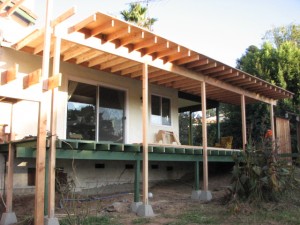
Part of the western side of the house (the rotten porch and overhang was rebuilt) What I’ve done is to replace the windows with energy-efficient glass. That helps, but it also insulates, so a cold house stays cold and a warm house stays hot. If the house had been built facing south, I probably wouldn’t have had to replace the windows at all, but just resealed them. I also painted that glaring southern wall a Mediterranean blue, which I find pleasing and helps keep the plants from cooking. It also helps absorb the heat in the winter. I installed a window on the south side, too, because there are gardens on that side. That helps brighten that room and allows in air and warmth. Thermal curtains are on every window, but I really hate closing them; I like to have the windows uncovered all the time (no really close neighbors). I have to pull them during the hot afternoons and during the cold evenings. I also have pull-down shades on the western porch to block out direct sun before it hits the windows. I installed a whole-house fan, which when turned on sounds as if a helicopter was landing on the roof. How it works is during a heat spell, when there is cool air coming in during the evening you open those doors, close the windows and doors upstairs, and the fan sucks the cold air into the house forcing it through the attic and outside through the air vents. The house cools down inside, the hot air in the attic is replaced by cooler air, and all the cats magically find hiding places you’ll never know about.
One fireplace now has a small wood-burning stove, which does throw more heat into the library but also only takes wood no longer than a foot, which is awkward since most firewood is longer. The other fireplace now has a Grate Wall of Fire http://www.gratewalloffire.com, which is an expensive grate and iron backing which positions the wood so that the embers deliver the heat out into the room rather than up the chimney. I absolutely love this product, and it was worth every penny. It makes lighting a fire easy, safe (the wood doesn’t roll into the room) and worth the effort.
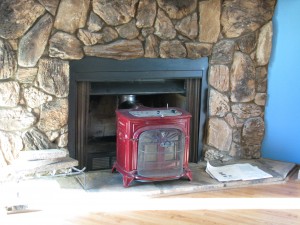
Wood burning stove is cute, but takes tiny logs. My big garage door faces east and is below the bedrooms. During the summer the morning sun hits that door and brings the temperature of the garage to a boiling point, and all that hot air rises to the bedrooms. I’ve put insulation between the support beams of the door and covered it with light plywood. The door won’t open automatically without a helping shoulder (I rarely open it anyway), but that insulation has made a tremendous difference in the temperature.
The house was always very dark inside. During the day I’d have to turn lights on to see. The overhang blocked a lot of sun, but was necessary to.. uh.. block a lot of sun. I installed Solatubes (http://www.solatube.com/) in the upper bathroom, living room, library, kitchen and in my daughter’s room which has no outside windows. What a difference! So much light comes into the house that I can even read without turning on a lamp in the daytime; we still make the mistake of thinking a light is on in the bathroom when it is just the Solatube reflecting out light. They have completely changed the character and feeling of the house to one of brightness and cheer.
The west side of the house is the tallest, where the yard is at level with a crawl-space under the house. When I moved in two huge pine trees blocked the western sun. Of course, within months they contracted a blight and died, and I had to cut them down (that is another story which involves a ladder, a handsaw, a rope, a breeze, and a lucky jump). I’ve replanted a tree which is slowly growing large enough to make a difference to the upper story, but it will also block the main view from the house of my much-improved gardens. Sigh.
If American houses were situated on lots so that they sat north and faced south, the savings in energy consumption from heating and cooling, the consumer savings in purchasing air conditioners, energy-efficient glass, insulation(view here for expert advice), lights, and the high labor costs of contractors would be tremendous. The personal comfort level of the inhabitants would be so much greater than there would be fewer fights and a healthier, more loving and peaceful atmosphere inside. Even with all the expensive changes I’ve made, the house is still hot in the summer and cold in the winter. If only I could pick the whole thing up and turn it forty-five degrees east. I love my house, but energy-efficiency shouldn’t be such a battle.
If you are looking for a house, building a house, or trying to find out why your energy bill is crazy high, take a good look at house placement. Permaculture isn’t just about planting plants, it is about sustainable and natural living.
-
December in Fallbrook
Coots on the pond Sunlight in the sleeping willows. Tranquility (try not to look at the houses). Tough and determined roots being fed by decaying golden leaves. An impromptu Christmas tree: a snag decorated with juniper, cranberries and bird seed. Lush green weeds keeping a low profile in the winter. Stately sycamores; their leaves shed to keep their roots warm. A season of greens, golds and blues. Coyote bush seed fluff glowing white instead of snow. -
Christmas Town
I love Christmas. I am a sucker for Christmas decorations. Slowly over the years, attending after-holiday sales, I added to the Christmas decorations for me and my children. Every year for many years I would let my son and daughter pick out a Hallmark Christmas ornament of their own. Our tree is decorated with the Three Stooges, a Klingon Battlecruiser, an Enterprise Shuttlecraft, and a Mole Christmas. In fact, when the tree is plugged in three voices chime in: one is saying, “Shuttle craft to Enterprise, shuttle craft to Enterprise. Spock here. Happy Holidays. Live long and prosper.” Another is Worf from Next Generation saying, “I wish you a most honorable holiday. Ka-plah.” Thirdly, and no less spectacularly, is, “Roger. Zero G and I feel fine. Capsule is turning around. Oh! That view is tremendous!” That was astronaut John Glenn in 1962 in the Friendship-7 shuttle, having the first view of the earth by a man in space.
The most labor-intensive part of the Christmas set-up, yet the most satisfying, is Christmas town. Years of going to Michael’s crafts store after Christmas to pick up the Dickensville Christmas town piece by piece, along with small houses collected along the way (I always have had a weakness for miniature houses), has coalesced into a city that, if not always size appropriate, certainly is well planned. My son used to set up the town, then after he moved out my daughter took over the planning. There is a business district, a central park area, the docks, a residential neighborhood, both upscale and poor, alleyways, and off in the mountains stands Scrooge in front of his dark home watching with hopefully spirit-changing surprise as Santa and his reindeer fly past. The town changes every year. It is always good to see the familiar faces: a mother and daughter feeding the birds, boys on a teeter-totter, and a little man just standing there having a cup of tea. Then in January, I pack it all away again, and enjoy having my house a little less cluttered for the New Year.
One of five boxes for the town. The B.U.M. box is where Scrooge’s house is stored. Just beginning to plan it out. Uptown. Districts seperated by roads and alleys. Toy factory in front of the skating rink. Scrooge outside his dark house in the mountains, with Santa! Telling tall tales by the dock. The blue-collar side of town. Feeding birds and playing by the town fountain. A man having a cuppa by the alleyways. Businesses open after dark. Loading a sleigh full of presents. Finished town during the day Town at night. -
Crunchy Cayenne-Cashew Candy
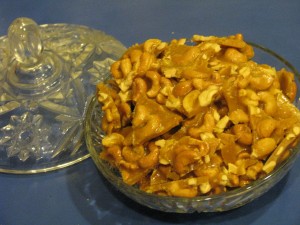
Bite-sized pieces of sheer yum (in my mother's candy dish). I don’t like very spicy foods. I like to taste the nuances of my food and not allow heat to overrule the flavors. However, a little heat now and then can be very nice. Heat can also be medicinal, helping everything from stomach upset and preventing colds to relieving the pain of arthritis. I have the perfect solution: a buttery, crunchy candy that has just a little burn to it. Yum! Originally from Gourmet magazine, I’ve been making it annually for Christmas for many years now, and it is hard to not polish off.
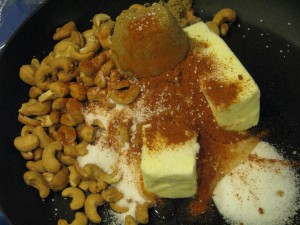
Put everything into a pan! It is simplicity itself to make. You put all the ingredients into a pan, heat it until the butter and sugar melts, turn up the heat until it begins to clump, pour it out onto a buttered cookie sheet and wait for it to harden. If it is still sticky, put the pan in the refrigerator for five minutes.
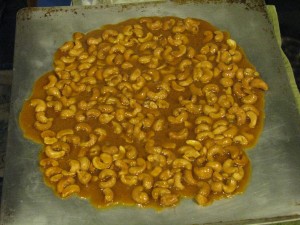
Pour out onto cookie sheet to cool. Crunchy Cayenne-Cashew CandyAuthor: Diane C. Kennedy (Gourmet magazine)Recipe type: DessertPrep time:Cook time:Total time:Buttery, crunchy, sweet, salty candy with a slight burn. Yum!Ingredients- 2 cups whole salted cashews
- 10 tablespoons (1¼ sticks) unsalted butter
- ½ cup granulated sugar
- ¼ cup packed brown sugar
- 1 tablespoon light corn syrup
- 1 teaspoon cayenne pepper
- ¼ teaspoon salt
Instructions- Butter a nonstick baking sheet and put aside.
- Combine all the ingredients in a large nonstick skillet.
- Stir over low heat until the butters melt and the sugars dissolve.
- Increase heat to medium and boil, stirring constantly until mixture turns golden brown, thickens and begins to mass together (about 5 minutes).
- Immediately pour out onto prepeared baking sheet, spreading evenly.
- Cool completely.
- Break into pieces.
- Makes about 1⅓ pounds.
-
Forget ‘Em Cookies

Store in a moisture-free container You really can’t forget these cookies. First of all, they are so tasty. Secondly, they are low fat and high in protein. Thirdly, they are exquisitely easy to make, especially after a day of baking. If you have two left-over egg whites (maybe from making lemon curd {see recipes}), you can make these merangues in a matter of minutes. Stir in some mini chocolate chips or broken chocolate pieces (or try toffee pieces, or crushed peppermint, or even some tiny mixed candied fruit), plop teaspoonfuls onto foil-lined baking sheets, put them in a 350F oven and turn off the oven. Leave sit with the door closed for 8 hours. Bingo. Beautiful, Christmassy, crunchy on the outside, slightly moist on the inside, with a definate chocolate yum. Make sure you use chocolate that you really like, because the flavor is dominate. You can also make these plain and they’d be just as wonderful. So make some, forget them… but remember them the next day! Store in a moisture-free container, because they will absorb moisture from the air and become sticky. If that happens, pop them back into the oven and turn off the heat again.
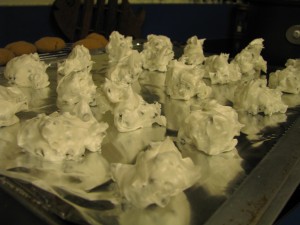
Mounds of fluffy goodness
Forget 'Em CookiesAuthor: Diane C. KennedyRecipe type: DessertPrep time:Cook time:Total time:Easy overnight meringues that take hardly any time to prepare, use up extra egg whites, and bake using residual heat from your oven. How environmentally friendly is that?Ingredients- 2 egg whites
- ½ teaspoon vanilla extract
- ¼ teaspoon cream of tartar
- ½ cup superfine sugar (or regular sugar)
- 6 oz. mini chocolate chips, chopped chocolate, crushed peppermint, toffee pieces, (optional)
- 1 cup chopped macadamia nuts or pecans (optional)
Instructions- Preheat oven to 350F
- Beat whites, vanilla and cream of tartar at high speed of an electric mixer until foamy.
- Gradually add sugar one tablespoon at a time until sugar is dissolved and soft peaks form (2-4 minutes; don't overbeat)
- Fold in chocolate and nuts, or whatever you choose. Or leave them out. It's your cookie!
- Drop mixture by heaping teaspoonfuls onto cookie sheets lines with aluminum foil.
- Place in oven.
- Turn off heat immediately.
- Forget 'em for 8 hours (don't even open the oven door!)
- Carefully remove cookies from foil
- Store in an airtight container for up to 1 week.
- Depending on whether you add chocolate and nuts, makes between 2 and 4 dozen.
-
Recipes

Recipes over time Something my mother and myself, and to some extent my mother’s mother, had in common, is the obsessive clipping of recipes. I began as a teenager, tearing recipes from the Sunday edition, storing them in a folder. The folder changed to multiple folders, then to a two-drawer filing cabinet, topped with a stuffed basket of wonderful edible possibilities glowing from scraps of magazine pages waiting to be sorted and filed.
Upon my mother’s death, I ended up with bags and bags of recipe clippings, some of which had been my grandmother’s. I couldn’t throw them away without looking through them. First of all, there might be something hidden amongst the papers that had some personal relevance. Secondly, it is like a journey back through decades, through my mother’s married life. The innocent times, post World War, when science and convenience foods would save us all from heavy labor and devastating illnesses through better nutrition and medicines. Recipes featuring the new packaged gelatins, junket tablets, buttery cream sauces and gravies. Thirdly, the love of cooking was perhaps the only strong link between my mother and myself. With forty-two years between us in age, too much history had happened in between to make us easy with each other. My generation selfishly and unquestioningly enjoyed the product of the efforts of her generation to make the world safer, healthier and more free. She had made dresses out of her aunt’s curtains as a child; I had everything I needed, therefore acted as spoiled as I was. Yet I sat on the kitchen counter feeding vegetables through the meat grinder for holiday stuffing, learned how to tell when baked goods were done by the smell, beat up bread dough and caressed pastry. Food wasn’t just good to eat, it was how my mother fully expressed her love for her family. The hard work planning, shopping, coordinating, preparing and serving nutrionally balanced meals. I learned that from her in my own way. I raised my children vegetarian, preparing all the meals, reading labels and shopping around for the best foods, trying to keep likes and dislikes in mind, never using a microwave or food processor, but making each slice personal.

Old recipe collections Going through the bags has taken me several years. It has been hard work. Being sentimental and having always been labeled as too sensitive, I am overwhelmed in the task. I think of my mother cutting, writing, making original recipes. One for peach crisp from a yellowed scrap of a New Jersey newspaper of 1959 was clipped two years before I was born. When she had four happy children still at home, in the house she and my father built amongst the trees in Point Pleasant, which I barely remember. Four hungry mouths to feed, plus my father who loved to eat, and relatives who would drop in for a game of cards. Mom would bake cakes, make sandwiches, happily feed the crowd. She wrote a cooking column called Beth’s Secrets to help support the large family. Mom entered the Pillsbury Bakeoff and won third prize, which included a trip to San Francisco for the judging. She decided that no matter what, the family would have to move to California; she was done shoveling snow.
Then there are the recipes dated when I was in high school, in college when there was just the two of them and only three of us kids left but all grown and flown. These are the ones that hurt the most, just as the ones I clip now do, too. When in our lifetime would we ever make these? Who for? Yet she still clipped up until the end. She had mountains of magazines that she hadn’t read, and as I bundled them up to recycle she insisted I leave the cooking ones because she would still go through them. I have the same bug. I have to look, I have to clip. Then when I want a recipe, I can’t find it, or I’m in a hurry and look in one of the hundred cookbooks I inherited from her, or more commonly now, Google it.
As I finish finally the last batch of her clippings, I find I’ve gleaned a small pile from it, recipes that I may just use sometime if… if I have grandchildren, if I have more mouths to feed. For recipes are hope for the future, a happy future when people can meet over a good meal and peace can reign if not on Earth, then just for a few hours over the dinner table.
My own bag of recipes is waiting for me to sort, although I’ve been much more discriminating since living alone most of the time. I really don’t want to put my children through the same emotional wringer of sorting through bags and files, but then, maybe they would just toss them. They are of the Internet age after all. I have reached to throw the clippings and files all in the recycler but something has stopped me. Perhaps that link with my past, perhaps the love of cooking, or maybe I know in my heart that if I keep them, I haven’t given up
hope for a happy future, highlighted with family and friends around a dinner table.
-
Becoming Very Behind in my Cleaning
-
Dragonfruit

Small ripening dragonfruit Dragonfruit have to have the most incredibly sensational color of any fruit. Their blooms are wild, showy and no better than they ought to be, and the fruit has colors so loud they bedazzle the eyes. Also known as pitaya or pitahaya, dragonfruit grow on either columnar or vining cactus plants. Their history is recorded with the Aztecs, and now they are grown in Vietnam and parts of Malaysia. Due to their soft texture, the fruit isn’t conducive to shipping and handling, so finding them at Asian marketplaces or Farmers’ Markets would be your best bet. However, the popularity of this plant is catching on and since they take up little room, can be grown at home.

There, amongst the proper cosmos, a wild flaunting beauty! I have two vining dragonfruit, which I’ve propped up on the trunks of two Washingtonia palm trees for support. They receive sun there, but some protection from the intense late afternoon sun, and it is a frost-free area. One morning in late summer I went out among the small cosmos and other English-style flowers of that yard, and suddenly noticed this enormous tropical flower looking so out of place. It was gorgeous, fragrant, and sultry next to the prim annuals. The flower of the dragonfruit has a nocturnal bloom, relying on bats and moths for pollination; apparently even those that are self-fertile, as this one evidently is, needs some interaction with bats and moths to set fruit. To insure pollination, growers will make an evening event of hand-pollinating, paint brushes and flashlights in hand. The flower slowly faded during the day and was limp in late afternoon; I’m glad I was lucky enough to see it in the morning at its most sensual state.

This gorgeous, fragrant flower was as large as my face. I didn’t think that the flower would set fruit, but the plant surprised me again when I glanced over last week and saw a red dragonfruit. This particular dragonfruit has red skin and crimson flesh. Some have red skin and white flesh, or yellow skin and white flesh. The most dramatic I’ve seen was a bright green skinned fruit with crimson flesh! All have small black seeds inside.

Hey, there's a dragonfruit! Dragonfruit is famed where it grows for its health benefits which are extensive, as well as the fiber and vitamins it contains. Dried dragonfruit is supposed to be more potent than fresh in some ways, and is a better eating alternative for those who don’t care for the texture of the fresh fruit. A good website honoring the nutrition aspect of dragonfruit is http://dragon-fruit.biz/ .

Red on the outside and crimson in the middle Propagation can be done by seed, which is slow, or by one-foot-long cuttings from fruit-bearing plants. Allow the cuttings to harden off before planting, just as you would any cactus or succulent. Plants will need support, especially the vining kind. They are tropical plants, so enjoy warm weather, regular watering without standing in water, and some humidity.
For sheer spectacular showiness, you can’t beat the neon colors of dragonfruit. Eat out-of-hand, in fruit salads, blend in smoothies or for sherbets, or dry to slightly chewy bits that are packed with nutrition. You will certainly impress your neighbors; in fact, invite them over for an evening pollination party! That ought to get the homeowner’s association all worked up!



